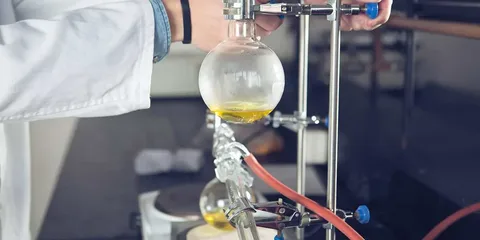Table of Contents
ToggleKey Takeaways
- Terpenes are essential oils comprised of hydrogen and carbon atoms, providing distinct aromas and flavors to various marijuana strains.
- Cannabinoids like THC and CBD contribute to marijuana’s psychoactive effects and potential therapeutic benefits, while terpenes primarily influence the plant’s aroma and flavor while also offering their own medicinal properties.
- The entourage effect is a remarkable phenomenon that arises from the synergistic interaction between terpenes and cannabinoids, enhancing the therapeutic potential of marijuana.
- Limonene, linalool, and pinene are terpenes with potential health benefits for high blood pressure.
- Terpenes offer significant potential in transdermal drug delivery systems for high blood pressure treatments due to their natural origin, safety profile, and effectiveness as penetration enhancers.
Defining Terpenes and Their Significance in Plants
Terpenes are essential oils comprised of hydrogen and carbon atoms, possessing potent medicinal properties and providing distinct aromas and flavors to various marijuana strains. As the most extensive, ancient, and diverse class of phytochemicals (plant-derived chemicals), over 40,000 unique terpenes have been identified across numerous plant species. These compounds serve critical functions in plants, such as attracting pollinators, deterring predators, and aiding in damage recovery.
Contrasting Terpenes with Cannabinoids
Cannabis plants contain both terpenes and cannabinoids; however, they perform distinct roles. Cannabinoids like THC (tetrahydrocannabinol) and CBD (cannabidiol) contribute to marijuana’s psychoactive effects and potential therapeutic benefits. In contrast, terpenes primarily influence the plant’s aroma and flavor while also offering their own medicinal properties.
Therapeutic Applications of Terpenes
Traditionally employed in medicine for their bioactive properties, terpenes can function as anti-inflammatory agents, analgesics (pain relievers), sedatives, or even exhibit antimicrobial characteristics. Recently, there has been an increased interest in utilizing terpenes as alternative treatments for various health conditions such as hypertension.
The Entourage Effect: Synergy between Terpenes and Cannabinoids
The entourage effect is a remarkable phenomenon that arises from the synergistic interaction between terpenes, the aromatic compounds responsible for the distinct smell of cannabis, and cannabinoids, the chemical compounds found in cannabis plants. This synergy enhances the therapeutic potential of marijuana, making it more effective for various medical applications.
One key aspect of this synergy is its ability to modify the blood-brain barrier – a protective layer that regulates the passage of substances from the bloodstream into the brain – and improve cell permeability. This allows for a more efficient delivery of cannabinoids to their target sites in the brain.
The entourage effect not only boosts the overall effectiveness of cannabinoids but also modulates their individual effects. For instance, terpenes can either amplify or dampen the effects of THC (tetrahydrocannabinol), marijuana’s psychoactive component. Likewise, terpenes can modify CBD’s (cannabidiol) impact, a non-psychoactive cannabinoid known for its potential therapeutic benefits.
This intricate interplay between terpenes and cannabinoids results in diverse potential outcomes based on their specific combination and ratio. Consequently, different cannabis strains can elicit varying effects on users despite having similar THC and CBD levels. By comprehending the entourage effect and its influence on user experiences, researchers and medical professionals can better customize cannabis-based treatments to address individual needs and conditions.
Exploring Terpenes: Potential Health Benefits and Sources

Limonene
Characteristics and Occurrence
Limonene, a highly prevalent terpene, is present in various plants such as citrus fruits, pine, juniper, rosemary, celery, fennel, caraway, and mint. Notably, it exhibits stress-relieving properties when found in medical cannabis.
Interactions and Mechanisms
This terpene interacts with several cannabinoids like CBD-A, CBC-A, THC-A, CBG, and CBC, as well as other terpenes including beta-caryophyllene and linalool. Limonene enhances its positive effects by increasing cell membrane permeability.
Stress Reduction and Blood Pressure Implications
A 1955 study reported that limonene treatment led to reduced antidepressant medication dependence in 9 out of 15 patients. It also improved immune system function and normalized stress hormone levels. Limonene increases serotonin availability and reduces anxiety-related symptoms by affecting adenosine receptors and promoting dopamine release.
These stress-relieving properties may help manage high blood pressure since stress contributes to hypertension.
Usage Methods and Strains
Limonene can be effectively utilized through aromatherapy, smoking, vaping or oral consumption. Sativa strains generally contain more limonene than hybrids or indicas; however, some strains with high limonene levels include Hindu Kush, Cookies and Cream, GG4, Emerald Jack, Liberty Haze, Lemon G, Cinex, Dirty Girl, Sour Diesel 2, Kosher Kush, and Argyle.
Linalool
Characteristics and Occurrence
Linalool is a terpene found in plants like lavender, basil, and coriander. Known for its calming effects and floral scent.
Potential Benefits for Blood Pressure
Linalool’s relaxing properties may benefit individuals with high blood pressure; however, more research is needed to determine its full potential in treating hypertension and other conditions.
Pinene
Characteristics and Occurrence
Pinene, a terpene with a distinct pine scent, is commonly found in pine trees, rosemary, basil, and eucalyptus. It possesses anti-inflammatory properties.
Potential Benefits for Blood Pressure
Pinene’s anti-inflammatory properties may help alleviate inflammation associated with high blood pressure. Further research is necessary to investigate pinene’s potential benefits for hypertension and other health conditions.
Terpenes: A Natural Solution for Transdermal Drug Delivery (TDD)
Terpenes, aromatic molecules found in plants and cannabis, have been identified as natural penetration enhancers (PEs) for transdermal drug delivery (TDD) systems. These systems involve administering medications through the skin to improve bioavailability, allowing drugs to reach target areas more efficiently.
Compared to synthetic PEs, terpenes offer a safer alternative with a lower likelihood of causing skin irritation or adverse effects. Their effectiveness in enhancing drug delivery across the skin barrier makes them a promising option for TDD systems.
The lipophilic nature of terpenes, which refers to their ability to dissolve in fats, oils, or lipids, is key to their mechanism of action as PEs. This property enables terpenes to interact with the skin’s lipid layers and increase permeability, facilitating deeper drug penetration and improved efficacy.
One potential application of terpenes in TDD systems is high blood pressure medication. By incorporating terpenes, these medications could become more effective by increasing bioavailability and reaching target areas more efficiently. This may lead to better blood pressure control and potentially reduce the need for higher doses or multiple medications.
In summary, terpenes offer significant potential in transdermal drug delivery, particularly for high blood pressure treatments. Their natural origin, safety profile, and effectiveness as penetration enhancers make them an appealing alternative to synthetic PEs. Ongoing research may reveal further applications of terpenes in TDD systems and contribute to the development of new therapies for various conditions.
Cannabis and Hypertension: A Complex Relationship
Interplay of THC and CBD with Blood Pressure
Hypertension, or high blood pressure, affects millions globally and escalates the risk of heart attack, stroke, and aneurysm. Intriguingly, cannabis exhibits both positive and negative impacts on blood pressure. Research indicates that initial cannabis use causes a minor yet discernible increase in heart rate and blood pressure, contingent on the quantity consumed. Nonetheless, the multiple compounds and diverse mechanisms of action in cannabis facilitate a reduction in blood pressure over time.
Endocannabinoid System (ECS) in Blood Pressure Regulation
The ECS is pivotal in controlling various physiological processes, including blood pressure. Comprising endocannabinoids (naturally occurring compounds), receptors, and enzymes, the ECS collaborates to maintain homeostasis. In hypertension, it modulates vascular tone and blood flow by adjusting the release of specific neurotransmitters.
Cannabis contains two primary active compounds: THC (tetrahydrocannabinol) and CBD (cannabidiol). Both interact with the ECS but influence blood pressure differently. While THC temporarily elevates heart rate and blood pressure, CBD’s vasodilatory properties can help reduce it.
Selecting Strains for Hypertension Treatment
Considering the intricate connection between cannabis and blood pressure, it is crucial to choose strains with an appropriate balance of cannabinoids for treating hypertension. High-CBD strains are generally more suitable due to their vasodilatory properties; popular options include ACDC, Harlequin, and Charlotte’s Web.
The terpene profile of a strain should also be considered when selecting one for hypertension treatment. Terpenes are aromatic compounds found in cannabis and other plants that offer various health benefits. Some terpenes like limonene and linalool exhibit stress-relieving properties beneficial for managing high blood pressure.
Cannabis Delivery Methods for Hypertension Treatment
Several methods exist for consuming cannabis for hypertension treatment, each with its pros and cons. Smoking or vaping allows rapid onset of effects but produces harmful byproducts during combustion. Edibles yield longer-lasting effects but take longer to activate and may be challenging to dose accurately.
Sublingual tinctures and transdermal patches are alternative methods that provide controlled dosing and steady cannabinoid release into the bloodstream. These methods circumvent the digestive system, enabling faster absorption and potentially improved bioavailability.
In summary, despite cannabis’s intricate relationship with blood pressure, it presents potential as a hypertension treatment option. By comprehending THC, CBD, and terpenes’ effects on blood pressure and selecting suitable strains and delivery methods, patients may find relief from this prevalent condition. However, consulting a healthcare professional before using cannabis for high blood pressure treatment is imperative.
Exploring Terpenes: Potential Therapies for Neurological and Psychiatric Disorders
Recent studies have unveiled the potential therapeutic effects of terpenes, naturally occurring compounds found in plants, for neurological and psychiatric disorders. Key terpenes such as pinene and linalool may offer new treatment avenues for patients with various mental health conditions.
Terpenes possess diverse bioactive properties, making them promising candidates for novel medicines. By optimizing the phytochemical profile of cannabis chemovars (varieties of Cannabis plants) to yield therapeutic levels of beneficial terpenes and cannabinoids like linalool, pinene, and CBD, we could uncover groundbreaking treatments for psychiatric and neurological illnesses. This approach might lead to more effective therapies with fewer side effects than traditional pharmaceutical drugs.
To optimize the phytochemical profile of cannabis chemovars, researchers can selectively breed strains to enhance the production of specific terpenes such as linalool and pinene. This process could result in cannabis strains tailored to target particular medical conditions or symptoms, offering patients personalized treatment options.
However, further research is crucial to fully comprehend the intricate interactions between terpenes, cannabinoids, and our bodies’ endocannabinoid system—a group of receptors involved in regulating various physiological processes. Clinical trials are necessary to determine the safety and efficacy of these compounds in treating different medical conditions.
As our knowledge of terpenes expands, so does their potential for harnessing therapeutic properties in treating high blood pressure and other health issues. With continued research and exploration, terpenes could significantly contribute to developing novel therapies for a wide range of ailments.
Conclusion
The Role of Terpenes in High Blood Pressure Management
Terpenes, the aromatic compounds found in plants, hold significant potential in alternative therapies for stress-related conditions such as high blood pressure. With a majority of Americans experiencing stress-induced physical and psychological symptoms, understanding the properties and benefits of terpenes like limonene, linalool, and pinene is crucial. These compounds may interact with cannabinoids (e.g., THC and CBD) to provide therapeutic effects on hypertension.
Terpenes: A Promising Avenue for Novel Treatments
Terpenes’ unique characteristics make them ideal candidates for innovative high blood pressure therapies. For example, they can serve as natural penetration enhancers (PEs) in transdermal drug delivery (TDD) systems, offering safer and more effective alternatives to synthetic PEs. Additionally, the entourage effect – the synergistic interaction between terpenes and cannabinoids – could potentially be harnessed to develop targeted treatments for hypertension and other conditions.
Advancing Research on Terpenes and High Blood Pressure
While terpenes show promise in treating high blood pressure, further research is necessary to fully comprehend their mechanisms of action, optimize cannabis chemovars’ phytochemical profiles, and investigate their potential therapeutic effects on neurological and psychiatric disorders. By promoting research in this field, we can facilitate the development of innovative therapies utilizing these natural compounds, ultimately improving the lives of millions affected by hypertension and stress-related conditions.








